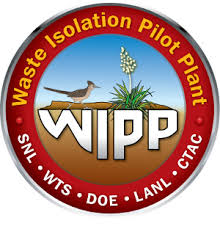The Waste Isolation Pilot Plant (WIPP) is a federal facility in an old salt mine near Carlsbad, New Mexico. The plant was completed about twenty years ago and put into operation to receive shipments of radioactive waste from national laboratories and nuclear weapon production facilities around the U.S. The waste includes special boxes and barrels packed with lab coats, rubber gloves, tools and debris contaminated with plutonium and other radioactive elements. No liquid is allowed in the drums that are shipped to WIPP.
The WIP has been operating for over two decades and has received almost thirteen thousand shipments. It is believed that the shifting salt in the old salt mine will eventually encapsulate the waste after the underground chambers are filled and sealed.
In 2014, a barrel from the Los Alamos National Laboratory was treated with a new absorbent that had not been sufficiently tested. The chemical processes in the barrel generated hydrogen gas which accumulated and eventually exploded. Problems with the air conditioning and filters allowed radioactive materials to escape from repository into the surrounding countryside.
The incident slowed down the federal government’s cleanup program. It also prompted policy changes at national laboratories and defense related sites around the U.S. New Mexico state regulators are considering a permit change that some critics say could make expanded operations at the WIPP possible. A final decision is expected later this year.
The WIPP was closed for three years while expensive cleanup and repairs were carried out. The repository is operating again. Lack of space became a serious concern following the 2014 event because some areas of the mine had to be close off.
The U.S. government has been mining a new chamber called Panel 8 at the WIPP. The new chamber took seven years to dig and will be put into use beginning next year. Workers still need to run power lines to the newly excavated. Air monitors and chain link to protect the walls also need to be installed.
Reinhard Knerr is a manager with the Department of Energy's Carlsbad Field Office. He said that the completion of Panel 8 had taken a long time, but it will be ready just in time because Panel 7 is expected to be full by next April.
The rooms that make up Panel 8 are three hundred feet long, thirty-three feet wide and fifteen feet high. Operators say that laser measuring devices were used to guide the mining machines that cut the salt. Big trucks were used to take the removed materials to a hoist that moved them to the surface. More than one hundred fifty-seven thousand tons of salt were mined during the Panel 8 project.
The next project at the WIPP will be for the mining machines to carve out passageways that will connect Panel 8 to a utility shaft that is currently under construction.
There have been a number of incidents at national laboratories and at the WIPP which suggest that regulations have not been followed properly in the operation of the repository. Hopefully things will run more smoothly in the future at the WIPP.
